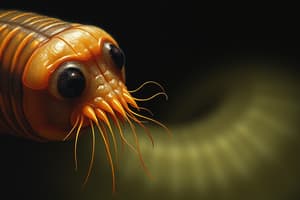Podcast
Questions and Answers
What is the role of nematodes in soil ecology?
What is the role of nematodes in soil ecology?
- Generating movement through coordinated muscle contractions
- Causing harm to host organisms
- Exhibiting a variety of behaviors
- Breaking down dead organisms and recycling nutrients (correct)
What is a characteristic behavior of nematodes related to survival?
What is a characteristic behavior of nematodes related to survival?
- Mating and reproduction
- Rapidly changing direction and navigating complex environments (correct)
- Contracting muscles in a coordinated manner
- Exhibiting foraging behavior
Which nematode species can cause whipworm infection in humans?
Which nematode species can cause whipworm infection in humans?
- Trichuris trichiura (correct)
- Ancylostoma duodenale
- Ascaris lumbricoides
- Nematodes do not cause infections in humans
What distinguishes parasitic nematodes from free-living nematodes?
What distinguishes parasitic nematodes from free-living nematodes?
What is a common characteristic of nematode reproduction?
What is a common characteristic of nematode reproduction?
What is the main characteristic of Phylum Nematoda?
What is the main characteristic of Phylum Nematoda?
What is the function of the tail region in nematodes?
What is the function of the tail region in nematodes?
How many described species are there in Phylum Nematoda?
How many described species are there in Phylum Nematoda?
Which body part of nematodes is responsible for digestion and other essential metabolic processes?
Which body part of nematodes is responsible for digestion and other essential metabolic processes?
What serves as a medium for the exchange of nutrients and waste products in nematodes?
What serves as a medium for the exchange of nutrients and waste products in nematodes?
What is the protective layer covering the body of nematodes called?
What is the protective layer covering the body of nematodes called?
What is the primary mode of locomotion for nematodes?
What is the primary mode of locomotion for nematodes?
What is the specialized structure in nematodes responsible for feeding and extracting nutrients?
What is the specialized structure in nematodes responsible for feeding and extracting nutrients?
Study Notes
Phylum Nematoda
Phylum Nematoda, commonly known as roundworms, is a diverse group of eukaryotic organisms that typically have a cylindrical shape and are characterized by the presence of a round cross-section. With over 17,000 described species, nematodes are one of the largest phyla of multicellular animals and can be found in various habitats, including soil, water, and other terrestrial environments. In this article, we will explore the anatomy, ecology, behavior, and parasitic aspects of nematodes, as well as their unique reproductive strategies.
Anatomy of Nematodes
Nematodes exhibit a wide range of body sizes, ranging from 0.1 to 5 mm in length, but they all share some common features. Their bodies are composed of three main parts: the head, the body, and the tail. The body is divided into a series of distinct segments, which are often used for classification purposes. The head region typically contains the mouth, esophagus, and pharynx, while the tail region is used for locomotion. The body segments in between are responsible for digestion, respiration, and other essential metabolic processes.
Nematodes lack a true circulatory system, and instead, their bodies are filled with fluid. This fluid serves as a medium for the exchange of nutrients and waste products. Their muscles are longitudinal and circular, contracting in a coordinated manner to generate movement, and they have a simple nervous system that consists of a nerve ring and ventral nerve cord.
Ecology of Nematodes
Nematodes are found in various habitats, including soil, water, and other terrestrial environments. They play a crucial role in soil ecology by breaking down dead organisms and recycling nutrients. In fact, nematodes are often referred to as "the recyclers of the soil". Some nematode species are free-living, while others are parasitic, living off the resources of their host organisms.
Nematode Behavior
Nematodes exhibit a variety of behaviors, including foraging, mating, and evading predation. They are highly motile organisms, capable of rapidly changing direction and navigating complex environments. Foraging behavior in nematodes is essential for their survival, as they need to locate food sources and avoid toxic compounds.
Nematode Reproduction
Nematodes display a wide range of reproductive strategies, with some species exhibiting both sexual and asexual reproduction, while others are strictly sexual or asexual. In general, nematode females produce numerous eggs, which can be laid in a variety of locations, depending on the species. Males are typically smaller than females and often play a more passive role in the reproductive process.
Parasitic Nematodes
Many nematode species are parasitic, and these parasitic nematodes can cause significant harm to their hosts. Some common parasitic nematodes include:
- Ascaris lumbricoides: This species is responsible for causing roundworm infection in humans, and can lead to a range of health issues if left untreated.
- Trichuris trichiura: Another human parasitic nematode, Trichuris trichiura can cause whipworm infection, which can result in severe abdominal pain and other health problems.
- Ancylostoma duodenale: This species is responsible for hookworm infection in humans, which can lead to iron deficiency and other health issues.
These parasitic nematodes can cause significant harm to their hosts, leading to a range of health issues and economic consequences.
Conclusion
Phylum Nematoda is a diverse group of organisms that exhibit a wide range of characteristics and behaviors. From their unique body structure and simple anatomy to their various ecological roles and reproductive strategies, nematodes are fascinating organisms that play a crucial role in our ecosystems. While some species are beneficial, others can be harmful, highlighting the importance of understanding these organisms and their ecological roles
Studying That Suits You
Use AI to generate personalized quizzes and flashcards to suit your learning preferences.
Description
Explore the anatomy, ecology, behavior, and parasitic aspects of Phylum Nematoda, commonly known as roundworms. Learn about their diverse characteristics, ecological roles, and reproductive strategies, as well as the impact of parasitic nematodes on hosts and ecosystems.




